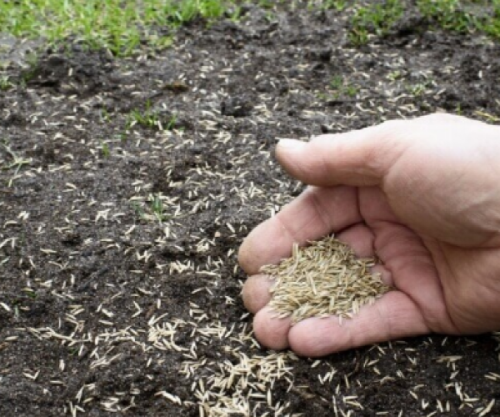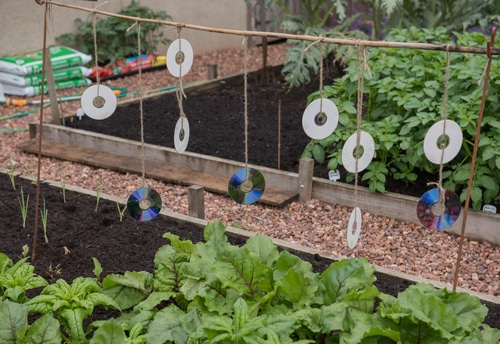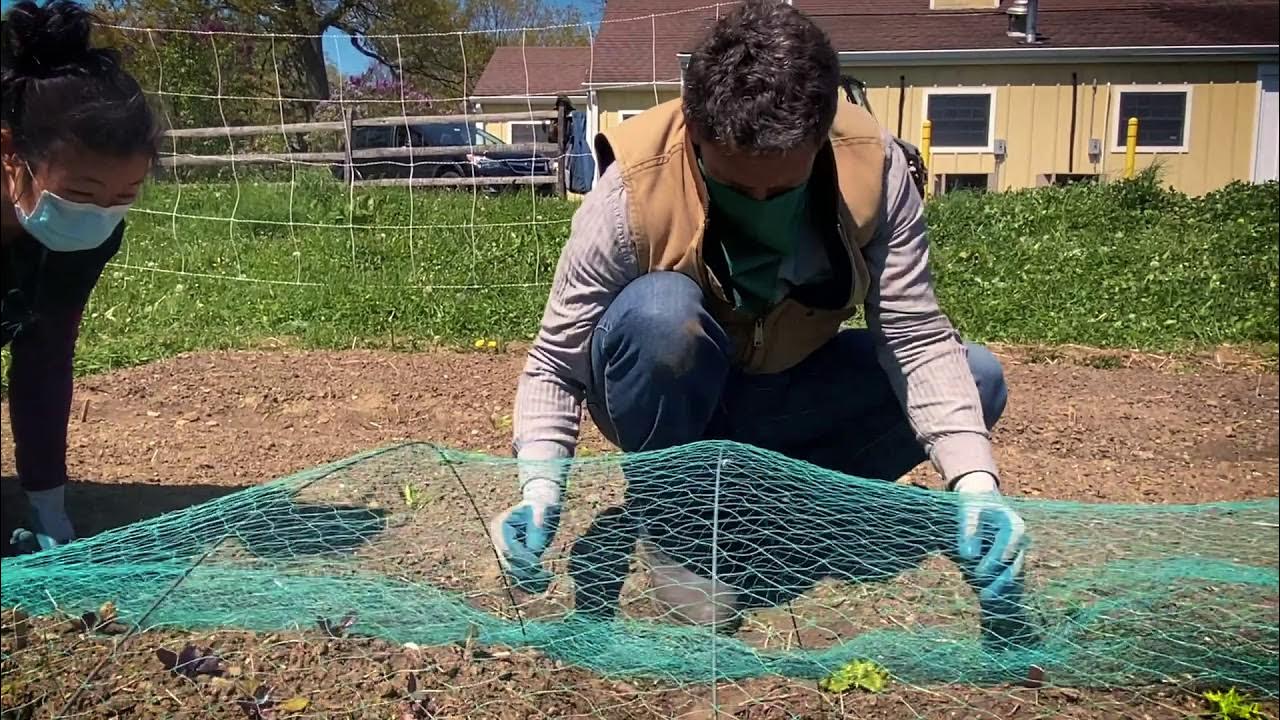Birds love grass seeds. So, protecting them can be a challenge.
But don’t worry, there are simple ways to keep your seeds safe. Grass seeds are a tasty treat for birds. If left unprotected, you might end up with bare patches instead of lush green lawns. This can be frustrating, especially after putting in the effort to plant the seeds.
The good news is, there are effective methods to deter birds from feasting on your seeds. By using some clever tricks and tools, you can ensure your grass seeds grow into a beautiful lawn. In this guide, we will explore practical tips and techniques to protect your grass seed from birds. Let’s get started on creating that vibrant lawn you’ve always wanted!

Credit: www.georgedaviesturf.co.uk
Choose The Right Time
Selecting the right time for planting grass seed can help protect it from birds. Plant during early morning or late afternoon. This timing reduces bird activity and allows seeds to settle.
When you’re trying to grow a lush, green lawn, timing is everything. Choosing the right time to plant your grass seed can significantly impact its success and keep those pesky birds at bay. Let’s dive into the best seasons and weather conditions to ensure your grass seeds get a fighting chance.Optimal Seasons
Choosing the right season to plant your grass seed is crucial. Generally, late summer to early fall is the best time. The soil is still warm, which helps with seed germination, and the cooler air temperatures reduce the stress on the young grass. Spring can also be a good time, but it comes with its challenges. The weather can be unpredictable, and birds are often more active in the spring. If you choose to plant in spring, be prepared to take extra steps to protect your seeds.Weather Considerations
Weather plays a significant role in the success of your grass seed. Avoid planting just before heavy rains. The seeds can wash away, and the soil can become compacted, making it difficult for the grass to grow. Check the forecast for moderate temperatures and consistent moisture. Ideal conditions are light rain and mild weather. This helps the seeds to stay moist without being drowned out or baked by the sun. Timing your planting with the right weather conditions can make all the difference. Have you ever planted seeds just before a rainstorm and watched them wash away? It’s frustrating, but it teaches you the importance of checking the weather. Choosing the right time to plant your grass seed is a simple yet effective way to protect your investment and keep the birds from feasting on your future lawn. What strategies have you found effective in your own gardening adventures? Share your thoughts in the comments!Prepare The Soil
Preparing the soil is a crucial step to protect grass seed from birds. Birds are less likely to disturb well-prepared soil. Healthy soil promotes faster grass growth, making it harder for birds to eat the seeds.
Soil Testing
Start with soil testing. Testing helps you understand the soil’s pH level. It also tells you about nutrient deficiencies. Purchase a soil test kit from a local garden center. Follow the instructions on the kit. Collect soil samples from different areas of your lawn. Send them to a lab for analysis. The results guide you in amending the soil.
Proper Tilling
Proper tilling is vital for seed protection. Tilling breaks up compacted soil, making it easier for roots to grow. Use a rototiller or garden fork for this task. Till the soil to a depth of about 6 inches. Remove rocks and debris during tilling. Smooth the soil with a rake. This creates a fine, even surface for planting grass seeds.
After tilling, water the soil lightly. This helps settle the soil and prepares it for seeding. Watering also deters birds from digging in the soil. A well-tilled and watered soil offers a better chance for grass seed to thrive.
Use Bird Repellents
Protecting grass seed from birds can be a challenging task. One effective method is to use bird repellents. This approach helps keep birds away and ensures your grass seed grows undisturbed. There are various types of bird repellents available, including natural and commercial options.
Natural Repellents
Natural repellents are a great way to keep birds away from your grass seed. These options are safe and environmentally friendly. You can use items found in your kitchen or garden.
Garlic and chili pepper spray can deter birds. Mix these ingredients with water and spray around your grass seed. Birds dislike the strong smell and taste.
Another option is using reflective objects. Hang shiny items like old CDs or aluminum foil strips near your grass seed. The reflections scare birds away.
Scarecrows can also be effective. Place a scarecrow in your garden to keep birds at bay. Move it around every few days to maintain its effectiveness.
Commercial Products
Commercial bird repellents are readily available and can be very effective. These products are designed specifically to deter birds and protect your grass seed.
Bird repellent sprays can be sprayed directly on the grass seed area. These sprays contain ingredients that birds find unpleasant.
Ultrasonic bird repellers emit sounds that birds dislike. These devices can be placed near your grass seed to keep birds away.
Bird netting is another effective commercial product. Cover your grass seed with bird netting to prevent birds from accessing the seeds.
Motion-activated sprinklers can also help. These sprinklers detect bird movement and spray water to scare them away.
Cover The Seed
Covering grass seed is essential to protect it from birds. Birds find seeds an easy meal, which can ruin your efforts. By covering the seed, you shield it from birds and help it grow better.
Mulching Techniques
Mulching is a great way to cover grass seed. Spread a thin layer of mulch over the seed. This keeps it hidden from birds. Mulch also helps retain moisture, which is good for seed growth. You can use straw, hay, or grass clippings as mulch.
Be careful not to smother the seeds. A thin layer is enough. This technique keeps seeds safe while providing a good growing environment.
Using Burlap
Burlap is another effective method to protect grass seed. Lay burlap over the seeded area. This creates a barrier that birds cannot penetrate. Burlap also allows sunlight and water to reach the seeds.
Secure the burlap with stakes or pegs. This ensures it stays in place. Remove the burlap once the seeds start to sprout. This method is simple and effective.
Install Bird Netting
Protect grass seed from birds with bird netting. Lay netting over the seeded area to keep birds away. Ensure the netting is secure to prevent damage.
Installing bird netting is one of the most effective ways to protect your grass seed from hungry birds. Bird netting creates a physical barrier that prevents birds from reaching the seeds. This method ensures your grass has the chance to grow undisturbed.Choosing The Right Netting
Selecting the right bird netting is crucial. You want a net that is durable and weather-resistant. Look for netting made of materials like polyethylene or polypropylene. Consider the size of the mesh. The holes should be small enough to keep even the tiniest birds out but large enough to allow sunlight and water to reach the seeds. Think about the coverage area. Measure your lawn to ensure you buy enough netting to cover the entire seeded area. It’s better to have a bit extra than to come up short.Installation Tips
Proper installation is key to effectiveness. First, lay the netting over the seeded area. Ensure it drapes slightly on the ground to prevent birds from sneaking underneath. Use stakes or pegs to secure the netting at the edges. This will keep it in place even in windy conditions. Space the stakes about every two feet for maximum stability. Make sure the netting is taut but not too tight. Loose netting can sag and create gaps where birds can get through. Conversely, overly tight netting can damage the grass seeds. Check the netting regularly. Remove any debris that may accumulate and adjust it if necessary. This will ensure that your grass seeds remain protected throughout the growing period. Have you ever tried bird netting before? What worked or didn’t work for you? Share your thoughts in the comments below!Set Up Scare Devices
Protecting your grass seed from hungry birds can be a real challenge. Birds can quickly eat up the seeds and ruin your hard work. One effective way to keep them away is by setting up scare devices. These devices can be visual or sound deterrents that make your garden less appealing to birds.
Visual Scare Tactics
Visual scare tactics can be quite effective in deterring birds. You can use shiny objects like old CDs or aluminum foil. Hang them around your garden to create reflections that scare birds away.
Another option is to set up decoy predators. Plastic owls or snakes can make birds think there’s danger nearby. Move these decoys periodically to keep birds from getting used to them.
Colorful pinwheels are also a fun and effective choice. They not only add a decorative touch but also create movement that birds find unsettling.
Sound Deterrents
Sound deterrents are another great option to keep birds away. Wind chimes can create noise that birds dislike. Choose chimes with varying tones for maximum effect.
You can also use electronic bird deterrents. These devices emit sounds that mimic predator calls. They can be particularly effective in scaring birds away.
If you’re on a budget, try creating noise with simple items. Clattering pots and pans together can be surprisingly effective in frightening birds off.
Have you ever tried these methods in your garden? Which worked best for you? Experimenting with different scare tactics can help you find the perfect solution to protect your grass seed from birds. Remember, the key is to keep the birds guessing and always feeling threatened.
Provide Alternative Food Sources
One effective way to protect grass seed from birds is to provide alternative food sources. By offering birds different and more appealing options, you can divert their attention away from your freshly sown grass seeds. This technique can be both practical and enjoyable, making your garden a haven for birds without compromising your landscaping efforts.
Bird Feeders
Bird feeders can be a game-changer. Place them strategically around your yard, away from the seeded areas. Fill them with bird favorites like sunflower seeds, millet, and cracked corn. This not only helps keep birds occupied but also adds an element of charm to your garden.
I remember setting up a bird feeder last spring. It was incredible to see how quickly birds flocked to it. My grass seeds remained untouched, and my garden came alive with chirping and fluttering.
Have you tried different types of bird feeders? Tube feeders, hopper feeders, and platform feeders all attract various species. Experiment with them to see which works best in your garden.
Decoy Plants
Decoy plants are another effective strategy. Birds love certain plants more than grass seed. Planting a few of these can draw birds away from your seeds. Consider plants like sunflowers, berries, or even marigolds.
Last summer, I planted sunflowers along the edge of my garden. Birds went straight for the sunflowers, leaving my grass seeds undisturbed. It was a win-win situation—beautiful flowers and a healthy lawn.
Think about your garden layout. Where can you add decoy plants to maximize their effectiveness? Would you prefer tall, vibrant sunflowers or low, bushy berries?
Providing alternative food sources is a practical way to protect your grass seed from birds. By adding bird feeders and decoy plants, you create a bird-friendly environment while safeguarding your lawn. Have fun experimenting with different options, and enjoy the beauty and activity they bring to your garden!

Credit: moowy.co.uk
Regular Monitoring
Protecting grass seed from birds requires regular monitoring. Birds can quickly spot and eat seeds, ruining your hard work. By keeping an eye on your lawn daily, you can ensure the seeds are safe and growing well.
Daily Checks
Daily checks are crucial. Walk around your lawn each day. Look for signs of birds. Check for pecked areas or disturbed soil. If you see any, take action quickly. Cover the seeds again if needed.
Adjusting Strategies
Adjusting strategies is important. If you see birds often, try new methods. Use bird netting, scarecrows, or reflective objects. See what works best for your lawn. Keep changing tactics to keep birds confused and away.

Credit: www.youtube.com
Frequently Asked Questions
How Do I Stop Birds From Eating My Grass Seed?
Use netting or burlap to cover the grass seed. Scare birds away with reflective objects, decoy predators, or noise deterrents.
What Can I Use To Cover Grass Seed?
Use straw, mulch, or compost to cover grass seed. These materials protect seeds from birds and erosion. They also help retain moisture, promoting better germination.
How Do You Protect Newly Planted Seeds From Birds?
Cover seeds with netting or garden fabric to deter birds. Use scarecrows or reflective objects near planting areas. Place bird feeders away from seeds to distract birds. Apply mulch over seeds to hide them. Use bird-repellent sprays or natural deterrents like garlic or chili powder.
What Is The Best Protection For Grass Seed?
Cover grass seed with straw or mulch to protect it. Water regularly and use a biodegradable seed mat for added security.
Conclusion
Protecting grass seed from birds is essential for a healthy lawn. Use netting, mulch, or bird repellent. These methods can save your grass. Consistent care ensures optimal growth. Simple steps lead to lush, green grass. A bird-free lawn is achievable.
Enjoy your beautiful, bird-safe yard.
